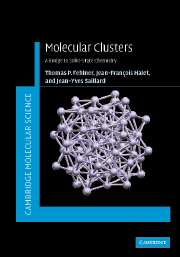Book contents
- Frontmatter
- Contents
- Preface
- 1 Introduction
- 2 Main-group clusters: geometric and electronic structure
- 3 Transition-metal clusters: geometric and electronic structure
- 4 Isolobal relationships between main-group and transition-metal fragments. Connections to organometallic chemistry
- 5 Main-group–transition-metal clusters
- 6 Transition to the solid state
- 7 From molecules to extended solids
- 8 Inter-conversion of clusters and solid-state materials
- Appendix: Fundamental concepts: a concise review
- Problem Answers
- References
- Index
- References
4 - Isolobal relationships between main-group and transition-metal fragments. Connections to organometallic chemistry
Published online by Cambridge University Press: 19 February 2010
- Frontmatter
- Contents
- Preface
- 1 Introduction
- 2 Main-group clusters: geometric and electronic structure
- 3 Transition-metal clusters: geometric and electronic structure
- 4 Isolobal relationships between main-group and transition-metal fragments. Connections to organometallic chemistry
- 5 Main-group–transition-metal clusters
- 6 Transition to the solid state
- 7 From molecules to extended solids
- 8 Inter-conversion of clusters and solid-state materials
- Appendix: Fundamental concepts: a concise review
- Problem Answers
- References
- Index
- References
Summary
The structural chemistry of main-group and transition-metal clusters has been set forth in the last two chapters. What more can be said about molecular clusters? Quite a bit, in fact. Although broad similarities between p-block and d-block cluster chemistries exist, we have illustrated important differences in structural preferences. The intriguing question, then, is what happens if p-block and d-block elements compete in a single cluster environment? Will the preferences of one element type dominate the other or will the merging of metal and main-group fragments generate possibilities not accessible to main-group or transition-metal systems alone. Perhaps clusters with novel hybrid properties will result.
But there is another perspective to mixed clusters. The transition-metal chemist sees the main-group fragment as a complex “ligand” through which structure and chemistry at the metal centers is perturbed. A p-block chemist may rather view metals as tools to systematically vary the structure and reactivity of a coordinated main-group moiety. Neither the cluster perspective nor the metal-complex view is wrong: one chooses a perspective optimal for the problem at hand. In this chapter we explore mixed p-block/d-block compounds as metal–ligand complexes with an emphasis on connections to organometallic chemistry. In Chapter 5 the focus will be the complementary cluster view.
Isolobal main-group and transition-metal fragments
In the first three chapters, instances were noted where the number, symmetry characteristics and occupation numbers of the frontier orbitals of a transition-metal fragment were similar to those of a main-group fragment.
- Type
- Chapter
- Information
- Molecular ClustersA Bridge to Solid-State Chemistry, pp. 139 - 164Publisher: Cambridge University PressPrint publication year: 2007

